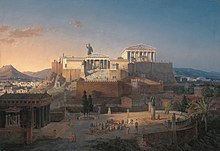Areopagus (modern times)
The Areopagus or Arios Pagos ( modern Greek Άρειος πάγος Ários págos ) is the highest court of civil and criminal jurisdiction in Greece .
history

The modern Supreme Court "Areopagus" (from ancient Greek Ἄρειος πάγος Arios Pagos " Ares hill") takes its name from the relevant in ancient Athens for the punishment of homicide supreme council of nobles , consisting of representatives of the nobility ( eupatridae ). According to Greek mythology, this is said to have been set up on the "Areshügel", a rocky hill northwest of the Acropolis , at the time of the reign of the mythical kings Kekrops and Theseus .
From the time of Solon in the 6th century BC The supreme council on the Areshügel was composed of former archons (representatives of the highest officials). Its responsibility then went to 462 BC. BC largely to the Heliaia, consisting of 6000 elected judges, and to the popular assembly (" Ekklesia "). The supreme council existed until late antiquity .
After the establishment of the modern Greek state, the highest court of justice of the free Greek state was created on October 16, 1834 by royal decree and officially named the ancient supreme council “Areopagus”. He started work in January 1835. The first decision was made on April 30, 1835 and published on May 1, 1835.
building
Until 1981, the Supreme Court was housed in the " Iliou Melathron " (Palace of Ilion, ie Troy), a palace originally built by the architect Ernst Ziller as the residence of Heinrich Schliemann in the center of Athens.
The current courthouse, Themidos Melathron , on Leoforos Alexandras in the Ambelokipi district was inaugurated on February 23, 1981. The facade bears the inscription "Themidos Melathron" (Palace of Themis ). According to mythology, Themis was the daughter of Uranus and the wife of Zeus, embodied divine justice and order and was the protector of the oppressed.
occupation
The President, the Public Prosecutor, the Vice-Presidents, the Judges and the Deputy Public Prosecutor of the Supreme Court are all working on Areopagus today. The members of the Supreme Court, like all judges, enjoy functional and personal independence. They are appointed for life and do not necessarily have to leave the service when they reach the age of 67 (Article 87 § 1 and 88 § 1 and 5 of the Constitution ).
Organization and tasks
The Areopagus decides through six civil departments that deal with cases of private law (contract law, commercial, inheritance, lien, labor law, etc.), three criminal departments and the plenum.
As the supreme court, the Areopagus does not review the factual findings of the lower courts. With the revision ( Greek αίτηση αναιρέσεως ), the appeal to appeal to the Areopagus, the review of the legal correctness of the challenged decision of the lower court is requested.
With its decisions, which are observed by the lower courts for the uniform treatment of similar cases, the Supreme Court guarantees the uniformity of case law in the interpretation and application of the law.
Web links
Coordinates: 37 ° 59 ′ 23.1 " N , 23 ° 45 ′ 11.3" E